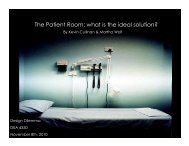The role of physical design and informal communication
The role of physical design and informal communication
The role of physical design and informal communication
Create successful ePaper yourself
Turn your PDF publications into a flip-book with our unique Google optimized e-Paper software.
extrapolating to an 8-hour frequency), average time per interaction, <strong>and</strong> average time<br />
<strong>of</strong> each interaction during an 8-hour shift. <strong>The</strong> data was also analyzed by week to<br />
assess whether there was a change over time. Observation <strong>and</strong> responses from<br />
focused interviews were used to further make sense <strong>of</strong> the CWM tool data.<br />
3.3.1 Analysis by Task<br />
a) Frequency<br />
Table 1 shows the percentage <strong>and</strong> frequency <strong>of</strong> each task over the entire eight<br />
weeks <strong>of</strong> data collection, <strong>and</strong> the average frequency during an 8-hour shift (see<br />
Appendix M for complete CWM tool category definitions). <strong>The</strong> “In Transit” category<br />
was used to record how frequently the GN walked between locations on the unit. As<br />
Table 1 shows, about one third <strong>of</strong> the GN tasks were “In Transit” (168 times on<br />
average during <strong>and</strong> 8-hour shift) which agrees with findings from previous research<br />
(Burgio et al., 1990). Note that “In Transit” was also the task with the highest<br />
frequency, followed by “Non Interactive,” which accounted for about one fifth <strong>of</strong> the<br />
tasks <strong>and</strong> occurred 120 times on average during an 8-hour shift. Looking only within<br />
the <strong>communication</strong> categories (Figure 19), about one third <strong>of</strong> the GN <strong>communication</strong><br />
was “Discussing Patient Care” (discussing patient status or care plan with staff or<br />
visitor) (30%), 27% was “Social,” (non-work related or venting about work) <strong>and</strong> 11%<br />
was “providing advice” (providing advice or guidance when someone lacks skill or<br />
knowledge). Given that the subject is a graduate nurse, it might seem odd that within<br />
the top three most frequent interactions was “providing advice.” However, it should<br />
be noted the staff the GN was advising were nursing assistants <strong>and</strong> nursing students,<br />
both <strong>of</strong> which have less training than the GN. During an average 8-hour shift, the GN<br />
discussed patient care 54 times, had 48 social interactions, <strong>and</strong> provided advice 21<br />
times (Figure 20). <strong>The</strong> most infrequently performed <strong>communication</strong> tasks were<br />
67







